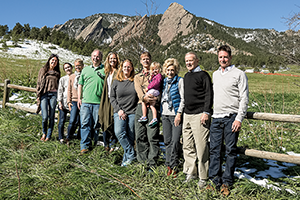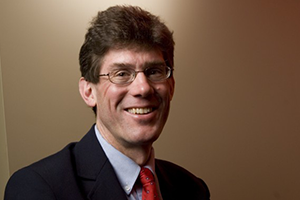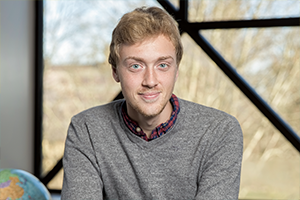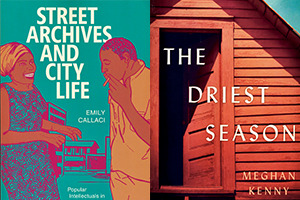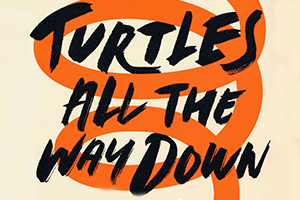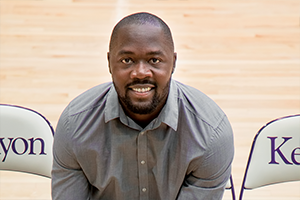Of Molecules and Metaphors
From doughnuts to e-cigarettes, Kenyon students use science to educate middle schoolers on addiction.
Read The StoryKenyon alumni from different disciplines explain how long-term stress takes a toll on our health — and how we can reverse its impact.
Story by Michael Blanding | Illustrations by Sam Falconer
Hurricanes in Houston and Puerto Rico. Wildfires in California. Mass shootings in Las Vegas and Texas. Sexual harassment in Hollywood. Health care uncertainty in Washington. The threat of nuclear war with North Korea. Government shutdowns. Opening up our Facebook feeds every morning can feel like an act of faith, and turning on cable news, an act of masochism. By the time you read this, no doubt, a half-dozen more catastrophic events will have eclipsed those above.
This barrage of bad news is taking its toll on our psyche. According to a poll released by the American Psychological Association in November 2017, 63 percent of Americans said the “future of our nation” is a “very significant source of stress” in their lives — edging out money, work and crime as their biggest worry. Even more significantly, 59 percent said this was the lowest moment in our nation’s history, “a feeling that spans generations, including individuals who have lived through World War II and Vietnam, the Cuban Missile Crisis, the September 11 terrorist attacks and high-profile mass shootings,” as the poll’s authors wrote.
While natural events such as hurricanes or earthquakes can make us feel out of control, that feeling is exacerbated when we feel like our political leaders are failing to address crises in our world, added Maryanna Klatt ’82, a professor of clinical family medicine at The Ohio State University College of Medicine who studies the effects of stress on the body. “When people say there is huge climate change going on, you want to feel like we have political leaders who are on top of the crisis and are dealing with it,” she said. “If you don’t, you feel disempowered.”
In psychological terms, this feeling is called “learned helplessness.” The term goes back to experiments in the 1960s by Martin Seligman, who found that dogs exposed to repeated shocks they couldn’t control would endure future shocks even when they were avoidable. The same thing, the theory goes, can happen to humans who are long exposed to situations in which they feel helpless, eventually leading to resignation, anxiety and depression.
It’s not just governmental inaction that can make people feel helpless these days, said Klatt; governmental overreach can also take away our sense of agency. “In education, all of the (required standardized) testing makes teachers feel like they can’t control their classrooms like they used to,” she said. “Under population health, doctors feel there are all these metrics they have to meet. With this increased level of accountability, people feel like they don’t have a voice.”
According to one Kenyon alumnus who works in stress management, our shared agita comes from the top. “Seventy percent of my counseling clients are very worried about an impulsive president and his many provocations,” said Leonard Felder ’75, a Los Angeles-based psychologist and author of 12 books on personal growth. “It’s a constant stress that causes people to have sleep problems, a short fuse and a sense of overall agitation.”
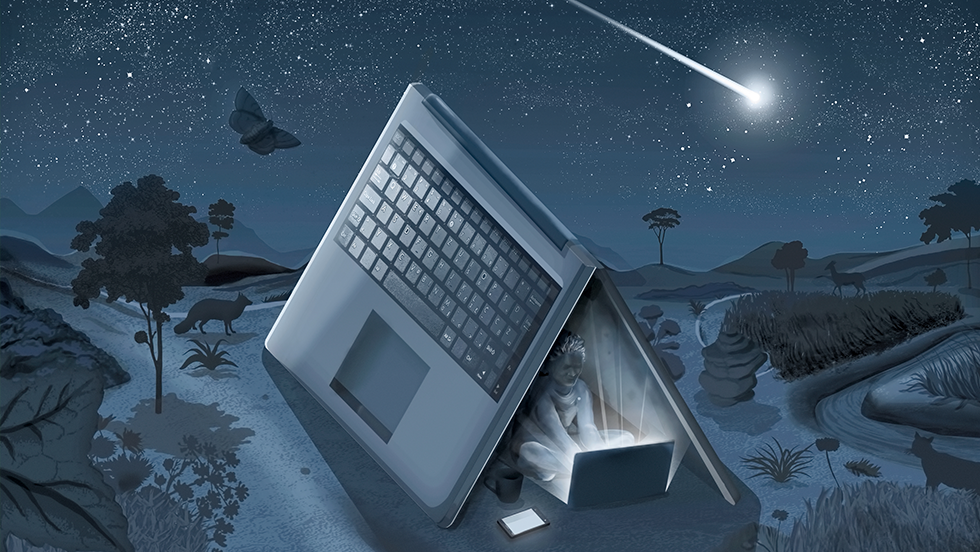
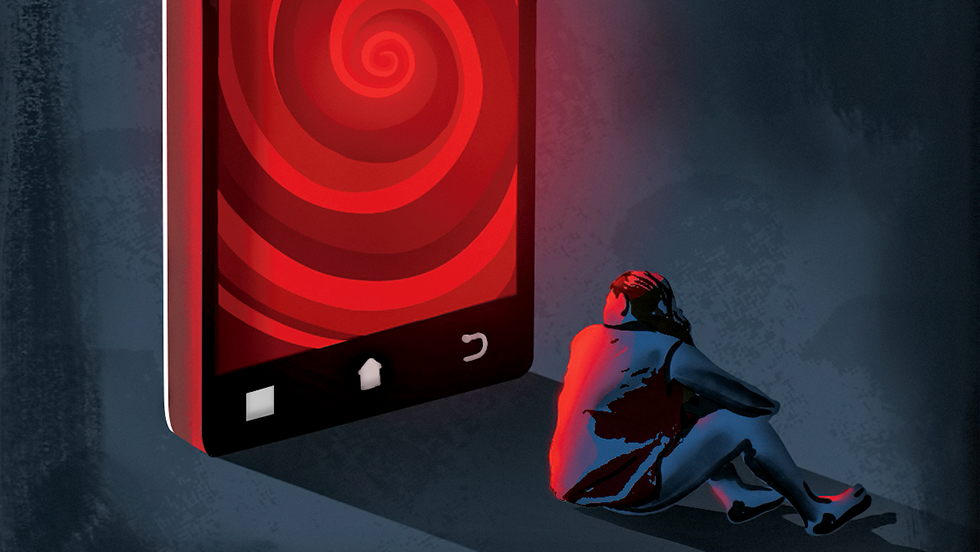
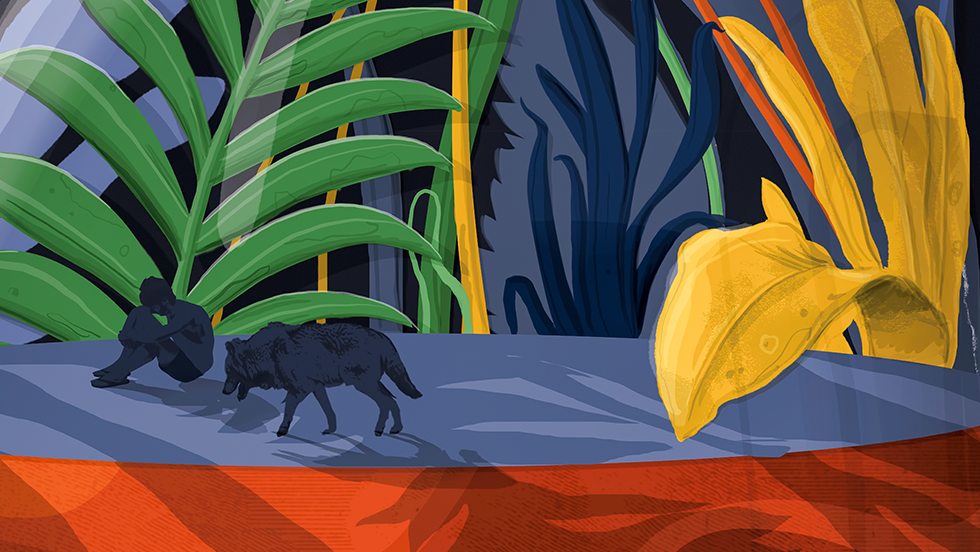
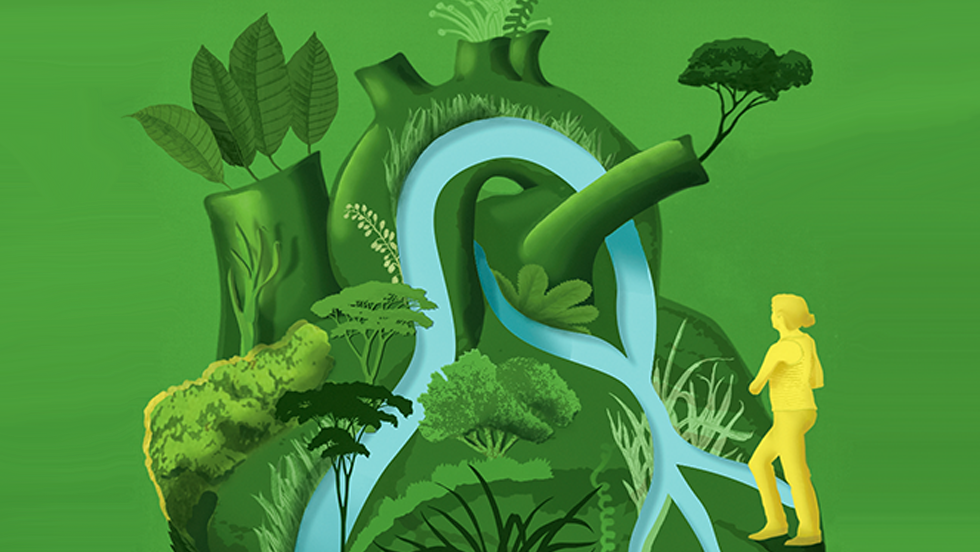
That unpredictability can have profound effects on our body, said Felder, causing us to stay in a constant state of readiness that exhausts our physical resources. “You begin to sense your breathing, your muscles, your nerves and your internal organs are all being overworked,” Felder said.
In 1936, Hungarian psychologist Hans Selye defined stress as “the non-specific response of the body to any demand for change.” Selye observed that animals exposed to extreme negative environments, such as bright lights and loud music, would over time develop diseases, including heart attack, stroke, kidney disease and rheumatoid arthritis.
That’s not to say that all stress is bad. In short bursts, stress can help us by priming our bodies to tackle perceived threats. “Acute stress can be good,” said Klatt. “It helps mobilize us for action. It’s like when you are getting ready for a talk, you have to kind of be pumped up to do your best job.” It’s only when stress becomes chronic — say, in the constant deluge of disasters in our Twitter feed — that it can be harmful. “You can’t keep up that level of being pumped up all the time, or your performance gets worse.”
Such a phenomenon is known as the Yerkes-Dodson Law, developed by psychologists Robert M. Yerkes and John Dillingham Dodson in 1908. They described a bell curve, in which a person’s performance improved with increasing amounts of physical and mental “arousal” up to an optimal point — after which, more arousal caused performance to diminish. Modern-day researchers have found a similar curve with stress, in which small amounts of stress can help people achieve their goals, while large amounts cause burnout.
In physiological terms, when we are exposed to stress, our brains instantly prepare a “fight-or-flight response.” Our amygdala, the part of the brain that controls base emotion — sometimes called our “lizard brain” — sends a signal to our hypothalamus, the “command center” of the brain attached to our autonomous nervous system. That, in turn, sends a message to our adrenal glands, which sit atop our kidneys, telling them to start pumping out adrenaline, a hormone that spreads throughout our body like Paul Revere sounding an alarm that we are under attack.
Our muscles tense, our breathing gets faster and our heartbeat speeds up, preparing us for action by getting oxygen to our muscles. At the same time, our liver kicks out extra glucose into the bloodstream to give us an extra jolt of energy. After that initial burst, adrenaline levels subside; if the threat continues, however, the body kicks in a second hormone, cortisol, to sustain the heightened levels of readiness. In the course of a normal day, cortisol usually follows a predictable circadian rhythm, increasing in the morning to jumpstart our day, and then falling throughout the day.
Like a car that overheats when its gas pedal is pushed down for too long, over time, high levels of cortisol are associated with inflammation in bodily tissues.
It’s when cortisol levels stay elevated for long periods of time that problems emerge, said Klatt. Like a car that overheats when its gas pedal is pushed down for too long, over time, high levels of cortisol are associated with inflammation in bodily tissues.
“Inflammation is often seen as a precursor to disease,” Klatt said. One way to measure that connection is through the levels of creactive protein (CRP) — a protein secreted by the liver in response to chronic inflammation. A Harvard study found that elevated levels of CRP in the blood more reliably predicted coronary events such as heart attack or stroke than high cholesterol. Other studies have shown elevated levels of CRP to be predictive of a host of other diseases, including inflammatory bowel disease, gastric ulcers, rheumatoid arthritis, lupus and migraines. “Whatever the weakest link is in your own physiology, that’s where problems likely will occur,” she explained.
Making things worse, chronic stress can also lead to behavioral issues caused by a desire to escape, such as overeating, sleeplessness, and drug and alcohol abuse, taking a further toll on the body. “We are all looking for a relief from the suffering,” said Sarah Bamford Seidelmann ’89, a former physician who now practices as a shamanic healer and life coach in Duluth, Minnesota, “and so we are shopping, or eating too much food that doesn’t serve us well, or we are drinking a half a bottle of wine at night, or a bottle of wine, or two bottles of wine — and all that compounds the stress.”
Seidelmann, who chronicled her personal transformation in a book, last year’s “Swimming With Elephants: My Unexpected Pilgrimage from Physician to Healer,” sees the destructive effects of stress on her clients. “Stress leaves us feeling muddled, confused, overwhelmed, frozen, unclear of what to do, or just staying in an extreme pattern of behavior that isn’t helping us,” she said. In her own life, she came face-to-face with chronic stress 10 years ago, when she felt unhappy and disconnected from her work after 14 years as a pathologist in a large health system. “I was more interested in finding out what makes people well than what makes them sick.”
She took a six-month leave of absence and began reading books on all aspects of physical and mental health, finally stumbling on a book about shamanism, a religious path based on ancient spiritual beliefs of indigenous peoples. She started applying the principles to her own life, however, and found they helped her feel more confident and productive — and when she started sharing with friends, found they, too, benefited.
In Seidelmann’s view, the stress we are experiencing at this moment in time is as much a spiritual crisis as a physical or emotional one. “From a shamanic standpoint, we might say everything that is going on right now is reflecting back our massive state of imbalance as a global family,” she said. Even Donald Trump, as divisive as he is, can be seen as a reflection of fractures that already exist.
One of the most helpful questions we can ask when we are feeling overwhelmed, according to Seidelmann, is, “‘What can I do to take care of myself?’ Maybe we need to look away from the glittering screens and really look inward, or spend some time in nature, which is a naturally restorative place.”
The scientific literature bears her out. Studies have consistently shown that exposure to nature improves people’s moods and reduces markers of stress. One study from Chiba University in Japan found that just taking a 15-minute walk in the woods caused cortisol levels to drop by 16 percent, along with a 2 percent drop in blood pressure and a 4 percent decrease in heart rate.
Another recent study by Stanford University researchers suggests a reason for these physical benefits; it found that a 90-minute walk in the woods significantly reduced “rumination,” the quality of thought that causes us to endlessly churn over anxious and unhappy thoughts in our head. Compared to those who walked in a city environment, the nature walkers reported experiencing a sense of restoration, fascination and belonging.
That decrease in focus on the threats in our lives — regardless of our actual situation — automatically sends a signal to our amygdala to take the foot off the gas. That, in turn, decreases cortisol levels, and restores breathing, heart rate and blood pressure to more relaxed levels, reversing the harmful physical effects of chronic stress.
Felder’s work has applied a similarly spiritual approach to stress reduction, though instead of shamanism, he finds his inspiration from his Jewish heritage. In his 2011 book, “Here I Am: Using Jewish Spiritual Wisdom to Become More Present, Centered, and Available for Life,” Felder describes how he was initially surprised to find solutions for stress reduction in Jewish spirituality. “I had never been told as a child during 12 years of twice-a-week Hebrew school,” he wrote, “that my Jewish heritage contained such extraordinary tools.”
He counsels a person to imagine a “silent Voice of Infinite Wisdom” quietly asking during a stressful moment, “Where are you?” and then the stressed person takes a breath, centers for a second or two, and then answers with the Hebrew word, Hineini (he-neh-nee), meaning “Here I am.” With practice, Felder said, his clients often report feeling more clear-headed and alert. “It’s like turning on a light inside your mind, body and soul that brings out the best in yourself,” he said.
In explaining how it works, he cites neuroscientific studies from the University of Montreal and the University of Pennsylvania that show that contemplative prayer and meditation can actually rewire the circuits of the brain. Instead of the “reptilian” parts of the brain, like the amygdala, such practices direct brain energy to the higher parts of the brain, such as the cerebral cortex, which focus on higher-order thinking such as advanced problem solving, affection and belonging, short-circuiting the fight-or-flight stress response.
Klatt has also explored the role of meditation in stress reduction through a program she developed at The Ohio State University called Mindfulness in Motion, a combination of yoga, meditation and music. Her program consists of an eight-week mindfulness-based intervention that is delivered to participants in the workplace once a week during their lunch breaks, “so people see stress reduction as part of their day, rather than something they have to add onto their already stressful lives,” she said.
The program focuses on using mindfulness to help people recognize sources of stress in their lives so they can begin to address them.
“A lot of times people don’t actually know what they find stressful,” she said. “You can’t get on top of any of what you find stressful until you are aware of it.” Similar to the effects of a walk in the woods on harmful ruminations, the program operates under the assumption that you cannot change the level of stress people experience in their work. “The only thing you can control is your reaction to it.”
In studies she has published based on the program, Klatt has found that it led to significant decreases in perceived stress, as well as a decrease in inflammation as measured by CRP levels in the blood, and sympathetic nervous system activation, measured by the presence of a biomarker in the saliva called salivary alpha-amylase.
In one study she performed with nurses in an intensive care unit at The Ohio State University Wexner Medical Center, she found that nurses actually weren’t overly stressed by the high-stakes medical emergencies in the unit, since they felt they’d been trained to handle them. The greatest stressors, instead, were patients’ families, who could be emotionally unpredictable, causing the nurses to feel out of control. By helping them become more mindful of their responses to such stressors, the program decreased the amount of salivary alpha-amylase by 40 percent over the eight weeks. “We couldn’t believe it ourselves,” Klatt admitted. “We checked it so many times for accuracy.”
Even more dramatically, the program had the effect of reducing stress for everyone on the unit — not just those who had participated in the program — a so-called “halo effect” from a general increase in calm. Klatt has done other studies on the program, finding that for people who were not overweight, the mindfulness program reduced CRP levels more than other interventions involving changes to diet and exercise. She is now teaching an undergraduate honors course at Ohio State that includes mindfulness interventions and features guest speakers from areas of government, medicine and business who talk about how they developed resilience to deal with stress at work.
“We teach people about dysfunction in psychology, but no one teaches people how to be resilient and happy. That training is something we need to be proactive about on every level.”
Maryanna Klatt ’82, a professor of clinical family medicine at The Ohio State University
“We teach people about dysfunction in psychology, but no one teaches people how to be resilient and happy,” Klatt said. “That training is something we need to be proactive about on every level.”
Being a stress researcher has its downsides, Klatt said — the biggest one being that once she tells people what she does, at parties, they inevitably unload on her all of the stress they are feeling in their own lives. But that just reinforces for her the need for people to develop mechanisms to better cope with their life stressors.
One piece of advice she always gives them is to monitor their screentime. The constant torrent of negative news from our Facebook and Twitter feeds only succeeds in feeding our sense of helplessness and loss of control, she said, introducing a medical term: “People need to focus on figuring out what their ‘minimum effective dose’ is,” she explained, “so they get the news, but don’t get depressed.”
Michael Blanding is a Boston-based award-winning journalist and bestselling author of “The Map Thief” (Gotham Books, June 2014). He has been practicing meditation for 20 years — but still has trouble shutting off his Facebook feed. | Sam Falconer is a freelance illustrator based in the Midlands, U.K.
For those looking to relieve stress by getting back to nature, Kenyon’s campus has an abundance of natural places they can use to soothe their anxieties. “One of Kenyon’s reputations is having this gorgeous campus, with tree-lined paths and historic buildings,” said Dave Heithaus ’99, director of green initiatives. “It’s hugely important, especially for students who are so scheduled down to the minute, to take a half-hour and get out into nature and connect with the place.”
He recommends heading out into the Brown Family Environmental Center (BFEC), a 550-acre bio-reserve cut through by the scenic Kokosing River. Recently, the center completed a new half-mile-long trail that leads from the observatory on campus down to Walker’s Pond, a large shallow pond surrounded by a mix of evergreen trees and deciduous forest.
Closer to campus, Heithaus has spearheaded the planting of a labyrinth, consisting of eight concentric rings lined with oak trees. Unlike a maze, a labyrinth has only one path, which pilgrims since the Middle Ages have used as a meditative journey to focus their thoughts as they head to its center. “It’s a chance to explore your thoughts, with nature as a context,” Heithaus said.
Erin Salva, director of student accessibility and support services, has her own favorite path in the BFEC, down from campus across Route 229, along the Kokosing River. There, the path is lined with massive Sycamore trees, along with several memorial benches seemingly made for contemplation. “It really is a magical place,” said Salva, who often sends students out to walk in nature as a way to calm their worries. “Many students walk with those earbuds in all the time and they are very tuned out,” she said. “But if you do it really intentionally, there is something about the repetitive movement of walking and swinging your arms that helps to heal the brain.”
On campus, Associate Director of Counseling Services Mike Durham often uses a little park tucked behind the new Market as a place to sit on a bench and collect his thoughts. Then, of course, there is Sunset Point, where students have been going for years to admire the view. “Each place has its own charm,” Durham said, “but the commonality between them is a feeling of being one with nature and a sense of interconnectedness. It helps in some ways to gain perspective about how little we ultimately are in the midst of a big world.”
When venturing out into one of these natural areas — or a similar special place near you — Maryanna Klatt ’82 offers the meditation below to help relieve stress and focus your thoughts.
"Becoming Middle Path: A Kenyon Meditation"
By Maryanna Klatt '82
Listen to the meditation on YouTube, accompanied by images of Kenyon and the surrounding area, or read the full text below.
Begin by bringing your attention to your body, where you are at this very moment. You may be on Middle Path or another spot that combines architectural balance and natural beauty. Look around you and take it all in, slowly and with intention, as if you are seeing it for the very first time.
Notice the rise and fall of your chest with each breath as you inhale and exhale slowly. Play with making the inhale and exhale equal lengths.
Notice the depth of your breath and relax into it, noting three cycles of deep slow inhales, followed by exhales equal in length to your inhale.
Pay attention to your feet, noticing that the
ball of one foot hits the ground as the heel of the other foot lifts to move you forward. As your breath slowed above, slow the pace of your steps so that you are conscious of the lift and fall of each foot. Feel the interplay between the surface of the ground, gravel, grass or snow, and attend to how your steps interact with it.
Observe the foliage, sky, beautiful sculptures and the buildings that hold inquisitive minds. Feel the energy of the interaction between the natural world and the quest to improve and understand our place within it.
Feel the freedom of inquiry and discovery that Gambier holds, as you become Middle Path, rather than simply a human being upon it. Become one with that which surrounds you, and that which is within you, aware of the interplay between them.
Appreciate the gift of these moments of freedom and immersion into what is beautiful and holds such potential. In the process of “becoming” Middle Path, you have opened this potential wherever your “Middle Path” is on a daily basis.
See beauty of your everyday journey, noticing your breath, body, cadence of emotions and reactions to the natural wonders around you. Take a deep breath in, and release, relaxed and refreshed, knowing Middle Path is always available to you.
Maryanna Klatt ’82 is a professor in The Ohio State University College of Medicine. She designs meditations for hospitalized patients as a nonpharmacological option for dealing with pain; stressed-out college students in need of positive coping mechanisms: and for health care professionals, so that they can be fully present, both for themselves and for their patients.
From doughnuts to e-cigarettes, Kenyon students use science to educate middle schoolers on addiction.
Read The StoryHow Margaret Willison '07 turned her love of pop culture into a mini media empire.
Read The Story

